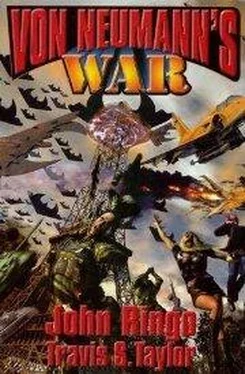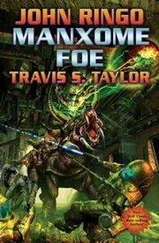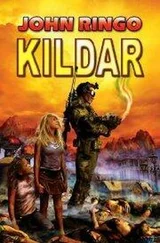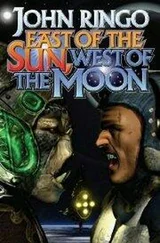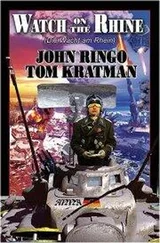Data from spectral analysis taken at further distances from the planet had already been downloaded. There were gases and metals but no signs of organic substances such as methane or ammonia. As the spacecraft approached closer to the planet the high resolution camera took priority on the download list.
Mission timeline approached fifteen minutes from minimum distance as the latest image dinged complete. The image had been taken sixty minutes to closest approach and had taken about forty-five minutes to download. As soon as the image download was complete, download of the next image in the sequence began.
Roger pulled the approach-minus-sixty-minutes image up and ran the post-processing software. The image sharpened on the screen in front of him and on several monitors simultaneously throughout the HOSC.
“Holy shit,” he muttered under his breath. At minus sixty minutes from Mars the spacecraft was about 50,000 km from the planet and so the image resolution was about 60 m per image pixel. And at 60 m per pixel all Roger could say was… “Holy shit!”
“Roger, am I seeing what I think I’m seeing?” Dr. Guerrero asked, pointing at a section of long straight lines interlaced in a gridlike pattern. Years at the NRO had trained him to notice artificial features in space reconnaissance imagery and Ronny recognized what he was seeing. But he couldn’t believe it.
“Roads perhaps? Or maybe high-rise buildings? But, these things are a couple hundred meters wide! I don’t understand what I’m seeing yet. The scale is just too… large,” Roger replied.
The next image in the sequence had begun downloading and thus far the mission was going as according to plan. The currently downloading image was acquired at 13,000 km from Mars with a resolution of about 20 m per image pixel. Roger had the raw data displayed as it was downloaded. The first few rows of the image filled in across the screen as the mission timeline ticked by. With no post-processing it was hard to determine what they were seeing, but it appeared to be a cityscape or industrial center, but very, very large.
“How could objects this big be manufactured from Martian soil so quickly and across the entire planet?” Alan asked over Roger’s shoulder.
“Dunno?” Roger said, stumped. “Magic.”
“Any sufficiently advanced technology…” Alan replied.
“Yeah,” Roger muttered. “That kind of magic.”
“Maybe we’ll understand it better when the image is finished and we can clean it up some.” Ronny scratched his head and took a sip from the Styrofoam coffee cup in front of him. “But, it looks like a civilization. A big civilization. That just… sprang up.”
“How much longer do we have to wait to get the rest of this 20 meter resolution?” Alan asked.
“Well, it’s been downloading about fifteen minutes or so. It’ll take about another thirty. I’m gonna grab a Coke, I’ll be right back.”
Roger stretched and stood from his chair. He pulled the headset off and rolled his head left then right. Tense didn’t begin to cover it — his neck felt like a steel wire.
“Mission Command, Watchdog reset on HGA requested. I’ve got an extreme load on the high-gain dish gimbals.” The C DH console rider shouted over the mike, loud enough for Roger to hear it all the way across the control room.
“Mission Command, we’ve got an Attitude Determination and Control Systems Alert. The star trackers are giving rapid angular acceleration of the spacecraft.” Another console report came in. “Momentum wheels are spinning erratic and the ACS thrusters have fired.”
Then multiple alerts at once were being reported. Roger sat back down and donned his headgear.
“Roger that, Watchdog reset. I’m showing no contact with Percival. I repeat… no contact with Percival. Has anybody got anything on their monitors?”
“Low bandwidth telemetry shows that multiple Watchdog software and hard resets were triggered. No further telemetry from the LGA is being received,” the C DH console operator said.
Roger waited patiently for reports from all consoles, but he was not at all happy with what he was hearing.
“Nothing from the low-gain antennas?”
“Negative, Roger.”
The final assessment was that contact with the probe had been lost.
“Okay, let’s start up the reconnect protocols and follow the procedures.”
Tom Powell sat back in his chair and made a Jetsons space car noise, blowing air through his pursed lips as he looked at something on his monitor. He muted his mike and turned toward Roger, Alan, and Ronny.
“You know, when I came up with the idea for that ‘Nuke Mars Now’ bumpersticker when all those probes started disappearing, I meant it then, and I reiterate the sentiment now. Once is happenstance, twice is coincidence, three times is enemy action: NUKE MARS NOW! I knew everybody should have listened to me!”
“Why?” Alan asked.
“Well, I’ve already compiled the alert signals — there weren’t that many of them — and the last one was of massive spacecraft bus structural integrity loss. The first alerts were from the exterior boxes, then they moved structurally inward to that final alert. All this took place in about a second or so. It looks to me like the spacecraft was dismantled from the outside inward. Fast. Something took it apart at a relative velocity of about 15 km/s to the planet. I mean, something flew up to it, matched velocity with it, then ripped it apart.”
“Tom, don’t jump to conclusions,” Alan said with a shrug. “Even if it flew apart, couldn’t they — whoever ‘they’ are — have just shot it down — not that that’s any better mind you — or couldn’t the spacecraft just’ve failed. I mean it could have just hit a micrometeorite or something.”
Roger looked at the big mission clock on the overhead screen. The mission time display told him that the telemetry commands sent back to the Mars probe should be getting there in about eight more minutes . Be patient , he thought to himself.
“Sure,” Tom argued. “But I don’t think that’s what happened. The data doesn’t support it. Nuke Mars Now!”
“Tom,” Roger said quietly.
“Yeah?” the rocket scientist replied angrily.
“It’s on the table. Now shut up.”
The eight minutes passed, then another ten, then another thirty and no response came back from Percival. More command signals were sent out — still no response.
After hours of searching for signals from the probe, the team finally decided that the spacecraft was lost. Most certainly the folks at the DSN would continue listening for the spacecraft for days, but as it stood at the moment, reestablishing contact seemed unlikely.
Roger and Dr. Guerrero had continued to check systems, talk to team members and just plain wait. The two of them had been holed up in the HOSC support room for more than twenty-two hours and it was time one of them said what they both had been afraid to. Roger rubbed his eyes, then yawned. He turned to the DDNRO who was adding another packet of sweetener to his coffee cup.
“Well, Ronny, it looks like somebody didn’t want us getting any closer to Mars.”
“Mr. President, Joint Chiefs, advisors.” Ronny Guerrero began the debriefing of the top advisors and leaders of the United States of America. The briefing was held in the secure room just down the hall from the Oval Office and was at the highest security protocols. Ronny had completed the mission that he had been asked to do and had done it well. The mission was as successful as it could have been. Success, however, was a bit moot at this point. Ronny had to tell the President of the United States what they had discovered and that the discovery might mean the end of the human civilization. The Mars mission was an easier task.
Читать дальше
